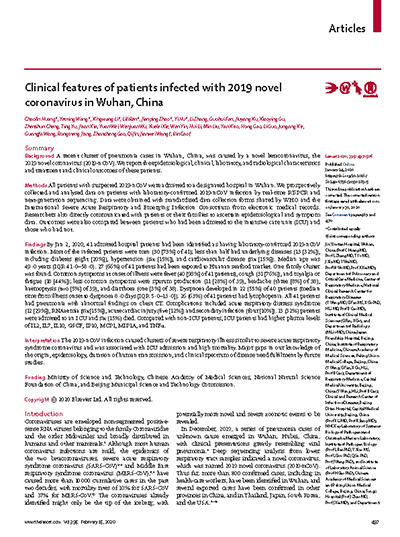Jan 24 Clinical features of patients infected with 2019 novel coronavirus in Wuhan, China
Chaolin Huang, Yeming Wang, Xingwang Li, Lili Ren, Jianping Zhao, Yi Hu, Li Zhang, Guohui Fan, Jiuyang Xu, Xiaoying Gu, Zhenshun Cheng, Ting Yu, Jiaan Xia, Yuan Wei, Wenjuan Wu, Xuelei Xie, Wen Yin , Hui Li, Min Liu, Yan Xiao, Hong Gao, Li Guo, Jungang Xie, Guangfa Wang, Rongmeng Jiang, Zhancheng Gao, Qi Jin, Jianwei Wang, Bin Cao. Lancet. 2020 Feb 15; 395 (10223): 497-506.
ABSTRACT
Background: A recent cluster of pneumonia cases in Wuhan, China, was caused by a new betacoronavirus, the 2019 novel coronavirus (2019-nCoV). We report the epidemiological, clinical, laboratory, radiological, treatment characteristics and clinical outcomes of these patients.
Methods: All patients with suspected 2019-nCoV were admitted to a designated hospital in Wuhan.
Data on patients with laboratory-confirmed 2019-nCoV infection were prospectively collected and analyzed by real-time RT-PCR and next-generation sequencing. Data were collected using standardized data collection forms shared by WHO and the International Registry of Severe and Emerging Acute Respiratory Infections from electronic medical records.
The researchers also communicated directly with patients or their families to collect data on epidemiology and symptoms.
The results were also compared between patients who had been admitted to the intensive care unit (ICU) and those who had not.
Findings: By January 2, 2020, 41 patients admitted to the hospital had been identified with laboratory-confirmed 2019-nCoV infection.
- The majority of infected patients were men (30 [73%] of 41).
- Less than half had underlying conditions (13 [32%]), including:
- Diabetes (eight [20%])
- Hypertension (six [15%])
- Cardiovascular disease (six [15%]).
- Median age was 49,0 years (IQR 41,0–58,0).
- 27 (66%) of 41 patients had been exposed to the Huanan seafood market.
- A family group was found.
- The common symptoms at the beginning of the disease were:
- Fever (40 [98%] of 41 patients)
- Cough (31 [76%])
- Myalgia or fatigue (18 [44%])
- The least common symptoms were:
- Sputum production (11 [28%] of 39)
- headache (three [8%] of 38)
- hemoptysis (two [5%] of 39)
- diarrhea (one [3%] of 38).
- Dyspnea developed in 22 (55%) of 40 patients (median time from illness onset to dyspnea 8,0 days [IQR 5·0–13·0]).
- 26 (63%) of 41 patients had lymphopenia.
- All 41 patients had pneumonia with abnormal findings on chest CT.
- Complications included:
- Acute respiratory distress syndrome (12 [29%])
- Anemia (six [15%])
- Acute cardiac injury (five [12%])
- Secondary infection (four [10%]).
- 13 (32%) patients were admitted to an ICU and six (15%) died.
- Compared with non-ICU patients, ICU patients had higher plasma levels of IL2, IL7, IL10, GSCF, IP10, MCP1, MIP1A, and TNFα.
Interpretation: The 2019-nCoV infection caused clusters of severe respiratory illnesses similar to coronavirus syndrome and was associated with ICU admission and high mortality.
There is a lack of knowledge about the origin, epidemiology, duration of human transmission and the clinical spectrum of the disease that should be studied in future studies.



